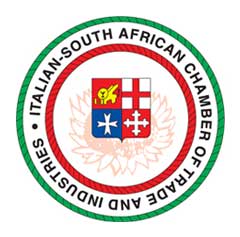La mostra Di Sarro al castello di Città del Capo apre la Settimana della Lingua Italiana in Sud Africa
- Details
- Created on Friday, 12 October 2012 14:49
 Fotoservizio di Claudio Farinelli -
Fotoservizio di Claudio Farinelli -
La Settimana della Lingua Italiana in Sud Africa si è aperta ieri con l'inaugurazione della mostra Di Sarro al Castello di Città del Capo, sede prestigiosa per un evento di grande spicco internazionale che ha coinvolto il Centro Luigi Di Sarro di Roma e il Consolato d'Italia a Cape Town, con la collaborazione della Dante Alighieri e nel quadro del Mese della Fotografia, che è uno dei principali appuntamenti culturali della città. Curata dalla nipote dell'autore, Alessandra Atti di Sarro, giornalista della Rai, la mostra offre al pubblico sudafricano la possibilità di sbirciare nella vita di Luigi Di Sarro, giovane medico e artista poliedrico, innocente vittima a 37 anni di quelli che sono passati alla storia come "gli anni di piombo". La mostra è infatti intitolata "It's my life" e le fotografie realizzate da Di Sarro negli anni 60 e 70 sono integrate da un breve filmato montato dalla nipote con immagini che lo zio aveva scattato per illustrare il proprio rapporto con l'arte e con la fotografia in particolare.
La mostra è stata aperta ieri sera con il discorso inaugurale del console Edoardo Vitali, con un intervento carico di emozioni di Alessandra Atti Di Sarro e con la relazione della dottoressa Carlotta Sylos Calò, autrice dell'ultimo libro pubblicato in Italia sulla produzione fotografica di Luigi Di Sarro. Il libro stesso sarà oggetto di una presentazione ufficiale lunedì sera alla Dante Alighieri. Erano presenti in sala esponenti della comunità italiana e del mondo dell'arte e della fotografia di questa città. Le fotografie esposte provengono in parte dal Centro Di Sarro, ma anche da diverse gallerie internazionali che le detengono, fra cui il Centro Pompidou di Parigi. Il console Vitali ha dedicato il suo discorso all'importanza della Settimana della Lingua Italiana, che si celebra contemporaneamente in tutto il mondo e che in Sud Africa si dipanerà attraverso conferenze, letture dantesche, proiezioni cinematografiche e concerti. A questo proposito il console ha sottolineato l'importanza, specialmente in questi tempi di ristrettezze economiche, di un coordinamento che consenta di utilizzare al meglio le idee, i progetti e le energie delle varie organizzazioni attraverso le quali gli italiani del Sud Africa esprimono la loro appartenenza a una cultura comune e a questa fanno riferimento. A tal fine fra qualche giorno una riunione in consolato dovrebbe gettare le basi di una più ampia e organica collaborazione fra tutti coloro che potranno essere utili all'elaborazione di un programma concordato di iniziative, soprattutto ma non soltanto in occasione di questa celebrazione annuale della nostra italianità.
Il console Vitali ha dedicato il suo discorso all'importanza della Settimana della Lingua Italiana, che si celebra contemporaneamente in tutto il mondo e che in Sud Africa si dipanerà attraverso conferenze, letture dantesche, proiezioni cinematografiche e concerti. A questo proposito il console ha sottolineato l'importanza, specialmente in questi tempi di ristrettezze economiche, di un coordinamento che consenta di utilizzare al meglio le idee, i progetti e le energie delle varie organizzazioni attraverso le quali gli italiani del Sud Africa esprimono la loro appartenenza a una cultura comune e a questa fanno riferimento. A tal fine fra qualche giorno una riunione in consolato dovrebbe gettare le basi di una più ampia e organica collaborazione fra tutti coloro che potranno essere utili all'elaborazione di un programma concordato di iniziative, soprattutto ma non soltanto in occasione di questa celebrazione annuale della nostra italianità. Alessandra Di Sarro ha raccontato l'artista suo zio, scomparso quando lei era ancora giovanissima, cominciando con i tragici eventi che indussero la famiglia e in prima fila la madre di Luidi Di Sarro, oggi centenaria ma ancora nel pieno delle sue risorse intellettuali, a perpetuarne la memoria attraverso la creazione del Centro Luigi Di Sarro, rivolto soprattutto a facilitare i primi passi di giovani di talento nel mondo dell'arte. Negli ultimi anni, nel perseguimento di questa missione, Alessandra e il marito Claudio Farinelli, in collaborazione con la Erdmann Photographic Gallery di Cape Town e con altri attori della scena artistica sudafricana, hanno realizzato diverse esposizioni di artisti sudafricani in Italia e di italiani in Sud Africa.
Alessandra Di Sarro ha raccontato l'artista suo zio, scomparso quando lei era ancora giovanissima, cominciando con i tragici eventi che indussero la famiglia e in prima fila la madre di Luidi Di Sarro, oggi centenaria ma ancora nel pieno delle sue risorse intellettuali, a perpetuarne la memoria attraverso la creazione del Centro Luigi Di Sarro, rivolto soprattutto a facilitare i primi passi di giovani di talento nel mondo dell'arte. Negli ultimi anni, nel perseguimento di questa missione, Alessandra e il marito Claudio Farinelli, in collaborazione con la Erdmann Photographic Gallery di Cape Town e con altri attori della scena artistica sudafricana, hanno realizzato diverse esposizioni di artisti sudafricani in Italia e di italiani in Sud Africa.
Infine la dottoressa Carlotta Sylos Calò ha raccontato come una decina di anni or sono, da laureanda, si sia imbattuta per caso nella produzione artistica e fotografica di Luigi Di Sarro e come si sia successivamente appassionata allo studio delle sue opere, fino a farne oggetto della sua tesi di laurea e alla successiva pubblicazione della stessa nel libro che giovedì sera lei stessa presenterà nella sede sociale della Dante. Nel 2001, ha raccontato la scrittrice, "vidi alcune fotografie che mi sembrarono semplicemente bellissime. Nella più completa ignoranza su chi le avesse prodotte e quando, mi impressionarono perché erano piene di potenza espressiva e ricche di suggestioni". Fu così che più avanti nel tempo, lavorando alla sua tesi per il master, quelle immagini le tornarono in mente e nacque l'interesse per Luigi Di Sarro e la sua arte, che ha finito per portarla anche a Città del Capo.
La mostra resterà aperta e liberamente visitabile fino al 21 ottobre. Qui di seguito i testi dei discorsi di Allessandra Di Sarro e di Carlotta Sylos Calò, nonché la notizia dell'inaugurazione apparsa stamane sul Cape Times.

It's My Life. Luigi Di Sarro
by Alessandra Atti Di Sarro
Thank you very much to be here with us to open this exibition. Luigi Di Sarro was my uncle. I was only fourteen years old when he died. He was 37 years old. The tragedy occurred in a very bad period in Italy, during the Red Brigades terrorism activity. Only a few weeks before that 24th of February 1979 the world was shocked by the killing of Aldo Moro, at that time one of the most important Italian politician. What happened to my uncle was a real tragedy, a terrible mistake. He was returning home from a party with a friend – that night was the carnival night – and he saw two men in the street, guns in hands, trying to stop his car. They were in plain cloths, there were no indications that they were policemen. He did not stop immediately. They shot and killed him. You can imagine what a court case followd this accident. A trial long almost 15 years: But he had been killed and his career ad been interrupted. So Luigi’s mother, - my granny, now 100 years old! – and the sister, my mother, decided to start up the Centro Luigi Di Sarro and go on to promote his art and young artists. That’s why I’m here today, to show you the photographic lab of Luigi, which is only a part of his imposing artwork. Maybe some of you can remember that we had two different exibitions here in Cape Town in an exchange project with the photogallery owned by Heidi Erdmann: this is a part of the Centro Luigi Di Sarro program to promote Italian art here and show South African art in Rome, where we are based.
This exhibition at the Castle of Good Hope - I must strongly thank the consul Edoardo Vitali for his support in the organizing and promoting –, this show, I was saying, would explore the vastness of the photographic lab of Luigi Di Sarro. He arrives at the photographic mode starting from a deep and a strongly emotional research about lots of different artistic techniques, painting and drawing above all, but also graphic and sculpture. He was looking for the possibility to make the artistic action more fluid in the space and time. Today, we could say that he was looking for the performance at all, but in the earlier 70's this was not a clear necessity for lots of experimental artists in Europe. The photography was also already prompt on the art scene. But what Luigi was studying was the possibility of the medium: he tried to make a drawing with a clever use of the camera lens, studio lights, screen patterns and subjects movement. Often using his self as the actor. Now we know this were the ways esplored by a lot of underground filmmakers or performing artists in the following 80’s, but we must remember that all of these works were dated ending 60's-first half of 70's.
Today some of the pictures you see here are exposed at the Pompidou Centre in Paris in a two year exhibition from the permanent collection of the contemporary art museum. The Pompidou achated 3 photographies, and 3 more were donated by the Di Sarro archive.
In this show we're trying to make sense of a fast and bulimic curiosity of the artist to the new possibilities he saw opened in front of his eyes using a camera. He wrote on a blocknotes: "... and if it's not enough, I go out from the canvas". Well, his photography was the strategy exit of an artists who lives his short life in a continuous searching.
This is what I can say, but I’m very proud to introduce you Carlotta Sylos Calò, she is the author of the last book about Luigi Di Sarro Photolab – about the book we’re going to have a specific conference to present it on Monday 15th October at La dante at 6pm. And I want to thank a lot all their staff for this added chance to speak about the Di Sarro work.
The Luidi Di Sarro Photolab -
by Carlotta Sylos Calò -
It's a great pleasure for me to be here today to talk about Luigi Di Sarro and welcome you to this exhibition. This is not only because I think it's always a pleasure to speak to an audience of people who are curious and interested in what we love, but also for the specific reason that I myself have approached the art of this artist visiting an exhibition.
It was by chance, I didn't konw Luigi Di Sarro.
It was the 2001, I was a young student of art history and once a month I used to go to National Gallery of Rome to see the collection. One day, during one of these walks, in the so-called 'hall of columns', I saw some photos that I found just beautiful. In total ignorance of whom and when those images may be produced it simply seemed to me powerful and rich of suggestions.
There were both black and white and coloured photos, there were portraits, studies on moving light, and body, every images caught my attention.
My spontaneous admiration for those photos brought me, almost ten years later, to remember it. So that, after graduation, in order to decide my doctoral dissertation in history of photography, I decided to make inquiries about Luigi Di Sarro. Since then I have written first a thesis and then a book. I studied, I saw the materials, trace to the techniques, but the thing that has not changed for me, also now that I can say to known quite well his photographies, is that sense of expressive power that continues to amaze me and it is renewed every time I see these materials.
Added to my first impression now there is the knowledge of an extraordinary artist, extraordinary not only because I think he is a 'good artist', but because he was capable of a genuine experimentation. He dared and used many materials, passing through design, engraving, graphic design, sculpture, photography, as well as theater and dance, always consistent with a love for knowledge and research that I think are rare and valuable, a very important inheritance also now that almost forty years are passed. He worked exploring every artistic tecnique with the strictness of a scientist and expecially with photography – that he used in particular the last ten years of his life, between the end of the sixties and the 1979, - it seems he found the perfect combination between art and science.
Here, in exhibition you have very good examples of that.
He used a normal Nikon camera and common films, and both black and white and colour depending on what he wanted to bring out, for example the graph value of the images, or the atmosphere, or the depth of the plans, or the light an the color itself. He used the camera as an extension of the eye and watched at everything, exploring reality. Both in the photographs of 'private type' and in those related to its artistic research Di Sarro explores the medium with great care. He is interested in shooting, looking for the point of view on things and people, often he used long time of exposure and sequence of shots. . He is fascinated by the reflections of the mirrors, the graphic quality of the backgrounds, colors and light, but also by the photographic process itself, printing included.
Looking at the photographs on this exhibition, you can see it. For example here, in this room, in the bigger photos we have the artist that portraits himself, using the long exposure times, drawing in the air with a small light bulb. Still to the movement are devoted these other photographs: always doing the shoot with a long time he recorded the movement in different positions. Here he covers with a colored gelatin some lamps and, crossing the ignition of the lamps to a sequence of shots, immortalize every position of his body or his head in a color.
In all these images we see him always in his laboratory, with the timer button in his hands and close by the light switch, being he both artist and scientist.
I hope that with my few words I have given you an idea, a lens trough which you can look at this images, even if I think, as it was for me, that this phographs can speak for themselves.
Of course I'm here if you have question and If you are interested in going deeper in the work of this artist you can come at the presentation of the book on the 15th. For now I thank you very much for your attention a I wish you a good evening.





















